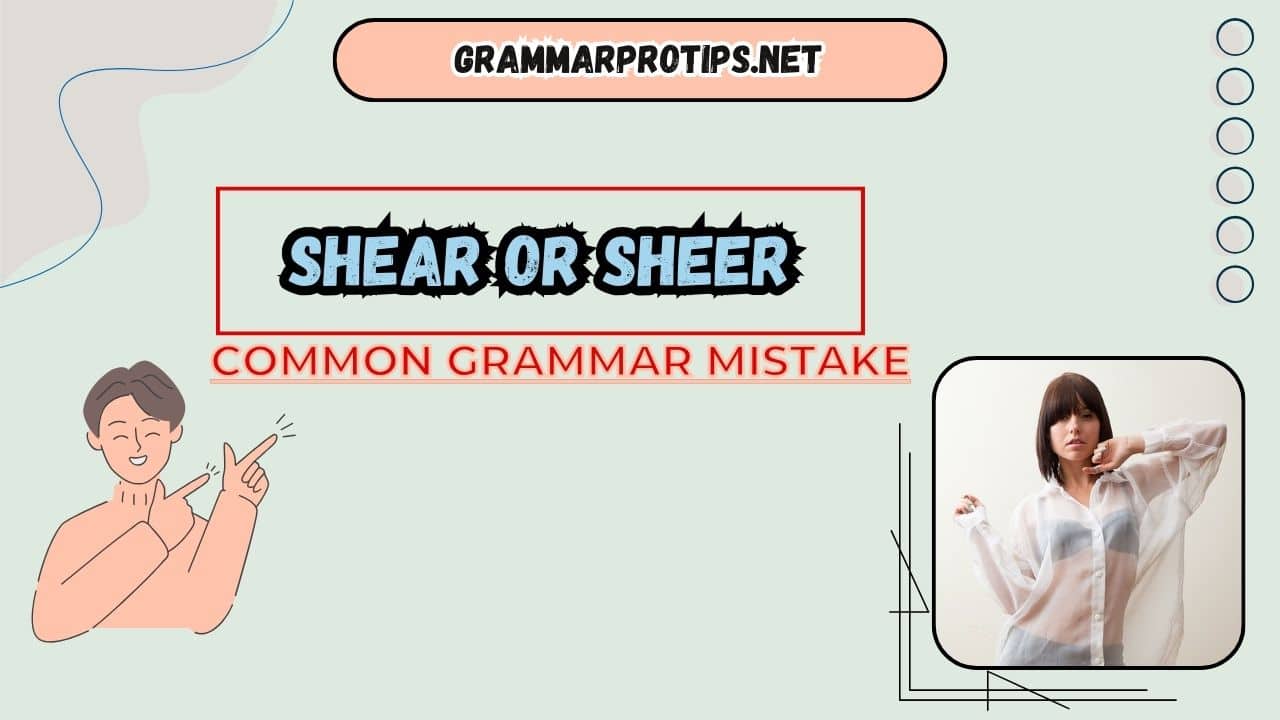The English language is riddled with words that sound the same but have different meanings, leading to a variety of grammar errors. One such pair of commonly confused words is “shear” and “sheer.”
While they may sound identical, their meanings are entirely different, and using them incorrectly can lead to a common grammar mistake.
Understanding the proper context for each term will ensure your writing is clear, precise, and professional.
In this article, we will dive into the specifics of shear and sheer, explore how they’re misused, and provide helpful tips on how to avoid these mistakes.
From sheer panic to shear force, we’ll break down these homophones and help you navigate their proper usage.
Understanding the Words Shear and Sheer
Before we explore scenarios and grammar tips, let’s start by defining the two words clearly.
Shear – Cutting, Trimming, or Force
The word “shear” refers to cutting or trimming something, usually with scissors or shears, or describes a force that can deform or break a material.
- Shear force is a technical term used in engineering and physics to describe forces acting on an object in a manner that causes parts of it to move relative to each other.
- The word is also used when referring to cutting tools like shears that are typically used in professions like hairdressing or gardening.
Example:
- “The barber used shears to trim my hair.”
- “The shear force of the wind was so strong it knocked down several trees.”
Here, “shear” is clearly about cutting, trimming, or force.
Sheer – Transparent, Thin, or Extreme
In contrast, “sheer” refers to something extremely thin, transparent, or utterly complete. It is often used to describe fabrics that are thin and translucent or to emphasize the extreme degree of something.
- For example, sheer fabric refers to clothing that’s so thin it allows light to pass through.
- Sheer can also describe an extreme degree, as in “sheer panic” or “sheer determination.”
Example:
- “She wore a sheer dress that was both stylish and delicate.”
- “The sheer cliffs dropped hundreds of feet into the ocean.”
How Shear and Sheer Are Commonly Confused
It’s easy to see how shear and sheer could be mistaken for one another. Both words are pronounced the same way, making them homophones.
Since they sound alike, many people mistakenly swap them, resulting in word misusage that can confuse readers or listeners.
Scenario 1: Email to a Friend
Let’s explore a typical scenario where you might see this mistake in an email to a friend.
Incorrect Use of Shear:
Subject: My Shear Dress
Hi Megan,
I just bought this amazing shear dress for the party this weekend. It’s so lightweight and perfect for the hot weather. The fabric is so light, I can almost see through it. Can’t wait to show you!
Best,
Emily
In this example, the word “shear” is used incorrectly to describe the thinness and transparency of the dress. Since the description clearly refers to something transparent and light, the correct word should be “sheer” instead of “shear.”
Scenario 2: Professional Email
In a professional context, the error could be even more serious, especially in technical writing. Here’s an example:
Correct Use of Shear:
Subject: Shear Force Impact on Bridge Stability
Hi Brian,
I’m writing to inform you about the shear force acting on the support beams of the new bridge. The load has been significantly higher than expected, which is causing some concern about potential structural damage. Could you please review the calculations?
Best regards,
David
In this example, shear is used correctly to refer to force acting on materials, a technical term commonly used in engineering. Mistaking this for sheer could mislead the reader, especially in a professional or technical setting.
Why Understanding Shear vs. Sheer Matters
In some cases, the confusion between shear and sheer doesn’t just make your writing unclear; it can completely alter the meaning of your sentence. By choosing the wrong word, you risk miscommunicating ideas, leading to confusion for your audience.
For example:
- “The shear cliffs on the coast were stunning” vs. “The sheer cliffs on the coast were stunning.”
In the first sentence, shear would suggest cutting or force, which is not the intended meaning. The second sentence uses sheer correctly to describe the extreme steepness of the cliffs.
Common Grammar Mistakes with Shear and Sheer
A significant grammar error happens when people use these words interchangeably because they sound the same. Here are a few common mistakes:
- Using Shear when Describing Fabric
Incorrect: “She wore a shear blouse.”
Correct: “She wore a sheer blouse.” Here, the blouse is made of thin, transparent material, so sheer is the appropriate choice. - Using Sheer to Describe Force
Incorrect: “The sheer force of the wind caused the tree to fall.”
Correct: “The shear force of the wind caused the tree to fall.” This is a case where shear describes the physical force that causes deformation.
Quick Comparison of Shear vs. Sheer
Here’s a quick table summarizing the key differences between shear and sheer to help you easily differentiate between the two words:
| Word | Meaning | Example Sentences |
|---|---|---|
| Shear | Cutting or trimming; force that causes deformation | “She used shears to trim the bush.” “The shear force caused the bridge to collapse.” |
| Sheer | Thin, transparent; extreme degree | “She wore a sheer dress.” “The sheer panic in her eyes was evident.” |
Detailed Scenarios of Shear vs. Sheer
Let’s now dive deeper into some more detailed scenarios where the misusage of shear and sheer could impact your writing or communication.
Scenario 3: Writing for a Fashion Blog
Imagine you’re writing a fashion blog about the latest trends in clothing. Here’s an example:
Incorrect Use of Shear:
Title: Top Shear Fabrics to Wear This Summer
When it comes to summer fashion, nothing beats the look and feel of shear fabrics. These materials are light, breathable, and add a touch of elegance to any outfit.
Whether it’s a shear dress or shear blouse, these garments will keep you comfortable and stylish during the warmer months.
The mistake here is using shear when referring to thin, transparent fabrics. The word sheer should be used instead, as it correctly describes materials that are delicate and almost see-through
Scenario 4: Email in a Technical Context
Suppose you are writing to a colleague in a technical field about a stress test on materials:
Correct Use of Shear:
Subject: Update on Stress Test Results
Hi Angela,
I wanted to update you on the results of the stress tests. The shear stress on the material was significantly higher than expected, which could lead to structural failure. Please review the data and let me know your thoughts.
Best regards,
Tom
Here, the correct term is shear because you’re talking about the force or stress applied to a material.
How to Avoid Shear vs. Sheer Confusion
To avoid mixing up these two words, here are a few tips that can help you choose the right one in any context:
1. Think About the Meaning
The most important step is to consider the context. Are you describing a cutting action or a force? Then the correct word is shear. If you’re describing something that is thin, transparent, or extreme, use sheer.
2. Read Your Sentences Aloud
Sometimes hearing the sentence can help you determine which word fits. If the sentence seems awkward or doesn’t make sense, reconsider your word choice.
3. Use a Synonym to Double-Check
If you’re unsure which word to use, try substituting the word with a synonym. If the sentence still makes sense, you’ve likely chosen the right word.
Conclusion
The confusion between shear and sheer is a common grammar mistake, but with some attention to detail, it’s easy to master.
By paying attention to the context, you can ensure you choose the correct word every time.
Whether you’re discussing a sheer blouse for a fashion piece or explaining shear force in an engineering report, understanding the correct word choice will improve your writing and help you communicate more clearly.
Remember, practice makes perfect! With a little effort, you’ll avoid these homophone errors and elevate your grammar and writing skills.
Read more knowledgeable blogs on Grammar Pro Tips

Sienna Mauldon is a passionate writer and grammar expert. On her blog, she shares easy-to-follow guides to help readers master grammar rules and improve their writing. With a love for language and teaching, Sienna makes grammar simple and fun for everyone, from beginners to experienced writers.








